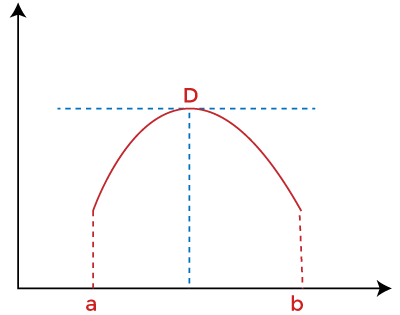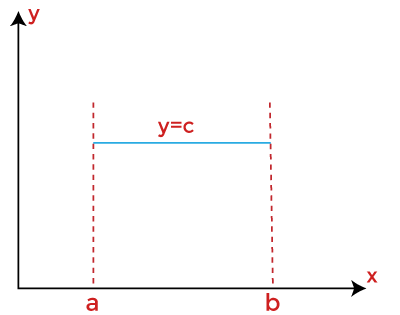Rolle's Mean Value TheoremRoll's theorem is a special case of the mean value theorem. Rolle's theorem states that if a f be a real valued function defined on the closed interval [a, b] where (a?x ?b) and differentiable in open interval ]a,b[where (a < x< b), and f (a) = f(b) then there is at least one value c in ]a,b[for which 
Proof of Rolle's mean value theorem If the function f is continuous in [a,b] and differentiable in open interval ]a,b[, with f(a) = f (b)=0 then there exist c in (a,b) where f' (c) = 0. Proof Let's suppose the two cases that could happen: Case 1: f(x) = 0 for all x in [a,b]. In the above case, the value that exists between a and b can serve as the c (mentioned in the equation), as the function is constant on [a,b], and as we know, the derivatives of constant functions are always zero. Case 2: f(x) = ? 0 for x in open interval ]a,b[ We know by the extreme value theorem that f accomplishes both its absolute minimum and maximum values somewhere on [a,b]. As we discussed above, f(a) = f (b)=0, and that in this case, f(x) is not equal to zero for some x in open interval ]a,b[. Therefore, f will have either positive absolute maximum value at some Cmax in closed interval [a,b] or a negative absolute minimum values in closed interval some Cmin in ]a,b[ or both. Take c to be either Cmax or Cmin, depending on which you have In the open interval ]a,b[ contains c, and either;
It means f has a local extremum at c. As f is also differentiable at c, Fermat's theorem applies and concludes that f' (c) = 0 Let's understand this concept with the help of an example Example 1: Verify Rolle's theorem for the function y = x2 + 3, a = - 2 and b = 2 Solution: We know the statement of the Rolle's theorem, the function y = = x2 + 3 is continuous in [-2 ,2] and differentiable in (-2,2) Given; F(x) = x2 + 3 F (-2) = (-2)2 + 3 = 4 + 3 = 7 F (2) = (2)2 + 3 = 4 + 3 = 7 Thus, F (-2) = F (2) Therefore, the value of f (x) at -2 and 2 coincide Now, F' (x) = 2x At c = 0, F'(c) = 2 (0), where c=0 ∈ (-2,2) Example 2: For all second-degree polynomials with y = mx2 + nx + k, it is seen that the Rolle's point is at c = 0. Also, the value of k is zero. Then find the value of n? Solution: Given; K = 0 We have to rewrite the function to get y = mx2 + nx Now, differentiating the function yields Y' = 2mx + n = 0 Equating it to zero we get the Rolle's point which is also zero 2m(0) + = 0 n= 0 Geometric InterpretationThe geometrical meaning of Rolle's mean value theorem states that the curve y = f (x) is continuous between x = a and x = b. At every point of time, within the interval, it is possible to make a tangent and ordinates corresponding to the abscissa and are equal then exists at least one tangent to the curve which is parallel to the x-axis. 
Algebraically, Rolle's theorem states that if f (x) is showing a polynomial function in x and the two roots of the equation f (x) = 0 and x = a and x = b, then there exists at least one root of the equation f (x) = 0 lying between these values. 
Questions based on Rolle's TheoremExamples 1 Verify Rolle's theorem for the function y = x2 + 5, a = - 3 and b = 3 Solution: We know the statement of the Rolle's theorem, the function y = = x2 + 5 is continuous in [-3 ,3] and differentiable in (-3,3) Given; F(x) = x2 + 5 F (-3) = (-3)2 + 5 = 9 + 5 = 14 F (3) = (3)2 + 5 = 9 + 5 = 14 Thus, F (-3) = F (3) Therefore, the value of f (x) at -3 and 3 coincide Now, F' (x) = 2x At c = 0, F'(c) = 3 (0), where c=0 ∈ (-3,3) Example 2: For all second-degree polynomials with y = ix2 + jx + k, it is seen that the Rolle's point is at c = 0. Also, the value of k is zero. Then find the value of j? Solution: Given; K = 0 We have to rewrite the function to get y = ix2 + jx Now, differentiating the function yields Y' = 2ix + j = 0 Equating it to zero we get the Rolle's point which is also zero 2i(0) + j = 0 J = 0
Next Topic#
|
 For Videos Join Our Youtube Channel: Join Now
For Videos Join Our Youtube Channel: Join Now
Feedback
- Send your Feedback to [email protected]
Help Others, Please Share









